What Is B2B SEO?
Business-to-business (B2B) SEO is the process of increasing organic rankings and traffic of B2B websites. The goal of a B2B SEO strategy is to rank high in the search results for keywords related to a business's products or services.
How Does B2B SEO Differs From B2C SEO?
The basic SEO concepts apply whether you do SEO for companies (B2B) or consumers (B2C). In both cases, you're trying to get the favor of search engines and the attention of people (decision-makers or normal users).
B2B SEO differs from B2C in who you want to target (audience) and what kind of content you use. Let's examine all the factors in more detail.
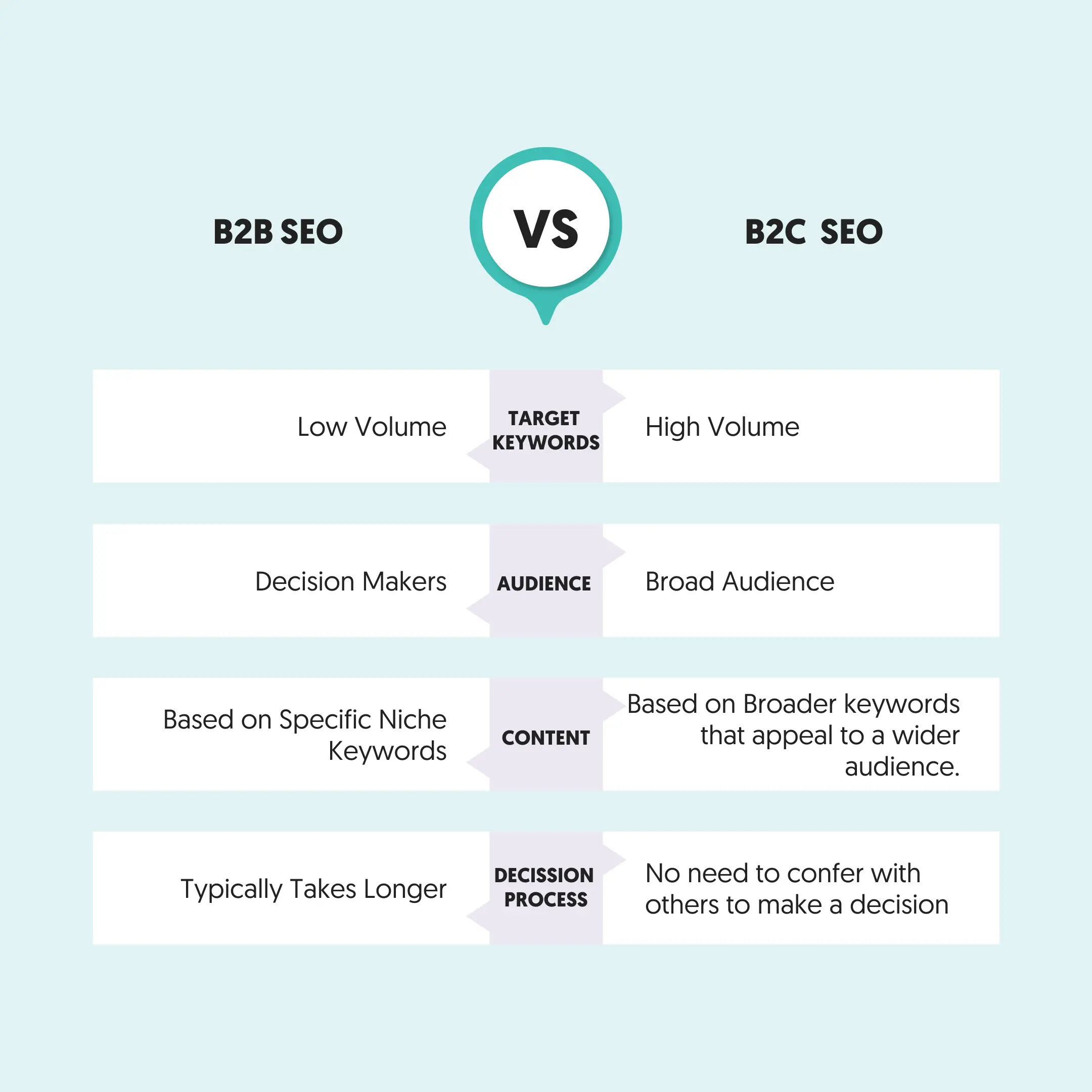
Target Keywords: In B2B SEO, you target very specific keywords. These are usually low-volume keywords with a transactional or commercial intent.
For example, a B2B SEO agency might focus on keywords like "SEO services for small businesses". These keywords are very specific and are usually searched by business owners looking for solutions or products to buy.
On the other hand, B2C SEO focuses on broader, more general keywords that appeal to a wider audience. These could be informational keywords like "What is SEO?" or even commercial keywords like "best running shoes".
Audience: B2B SEO's audience consists of people making decisions on behalf of their organizations. They can make the decisions themselves or look for information to present to a board or group.
For example, a marketing executive might be looking for a reporting tool and want to gather relevant information to present to their manager, who will make the final decision.
For B2C SEO, the audience is anyone interested in the product or service. This can range from teenagers looking for the latest fashion trends to parents searching for the best educational toys for their kids.
Content: B2C and B2B SEO content must be engaging, high-quality, and easy to consume. The main difference is that B2B content has to show credibility and authority to convince decision-makers using facts and figures. It is more detailed and includes references to case studies and reports to validate claims.
In our example above, the company selling a reporting tool should create detailed guides showing how their tool can help businesses with their reporting needs.
Their content should highlight the problems a company is trying to solve and how their solution can solve these problems. It should include references from other customers and studies showing the effectiveness of their platform.
Decision Process: The decision-making process in B2B SEO is more complex as it might involve multiple people. When purchasing on behalf of a company, you need to consider various factors (cost, vendor reputation, legal factors, after-sales support, etc.) and get approval, which takes more time than impulse buying decisions.
Why Is SEO Important For B2B Marketing?
SEO can benefit any business, but it's particularly important for B2B marketing. Here is the critical point: if you want people actively searching for your products or services to visit your website and consider your offering, you need to appear in the top positions of Google for your target keywords.
If you fail to do that, you'll lose clients to competitors. So, B2B SEO is not just about increasing your online visibility and search traffic, but it's about getting a client first before your competitors.
Furthermore, investing in SEO will generate a higher ROI than other marketing channels (such as Social or PPC Marketing), which is a better use of the marketing budget. According to studies, SEO ROI is 29.2%, compared to 18.8% for social media and 12.3% for PPC.
So, now that you're convinced that SEO is the best marketing approach for companies in the B2B industry let's see how to create a winning strategy.
How To Create An Effective B2B SEO Strategy
- Develop Comprehensive Buyer Personas
- Conduct B2B Keyword Research
- Map Keywords to The Sales Funnel
- Develop a B2B Content Strategy
- Optimize Landing Pages For B2B Customers
- Promote Your Content To Get Mentions and Backlinks
- Review Technical SEO And Fix Any Issues
1. Develop Comprehensive Buyer Personas
The first step is to define your target audience by creating buyer personas. This process doesn't have to be complicated, and you don't need a tool. Use our template below as the basis of your research and try to learn as much as possible about your potential buyers.
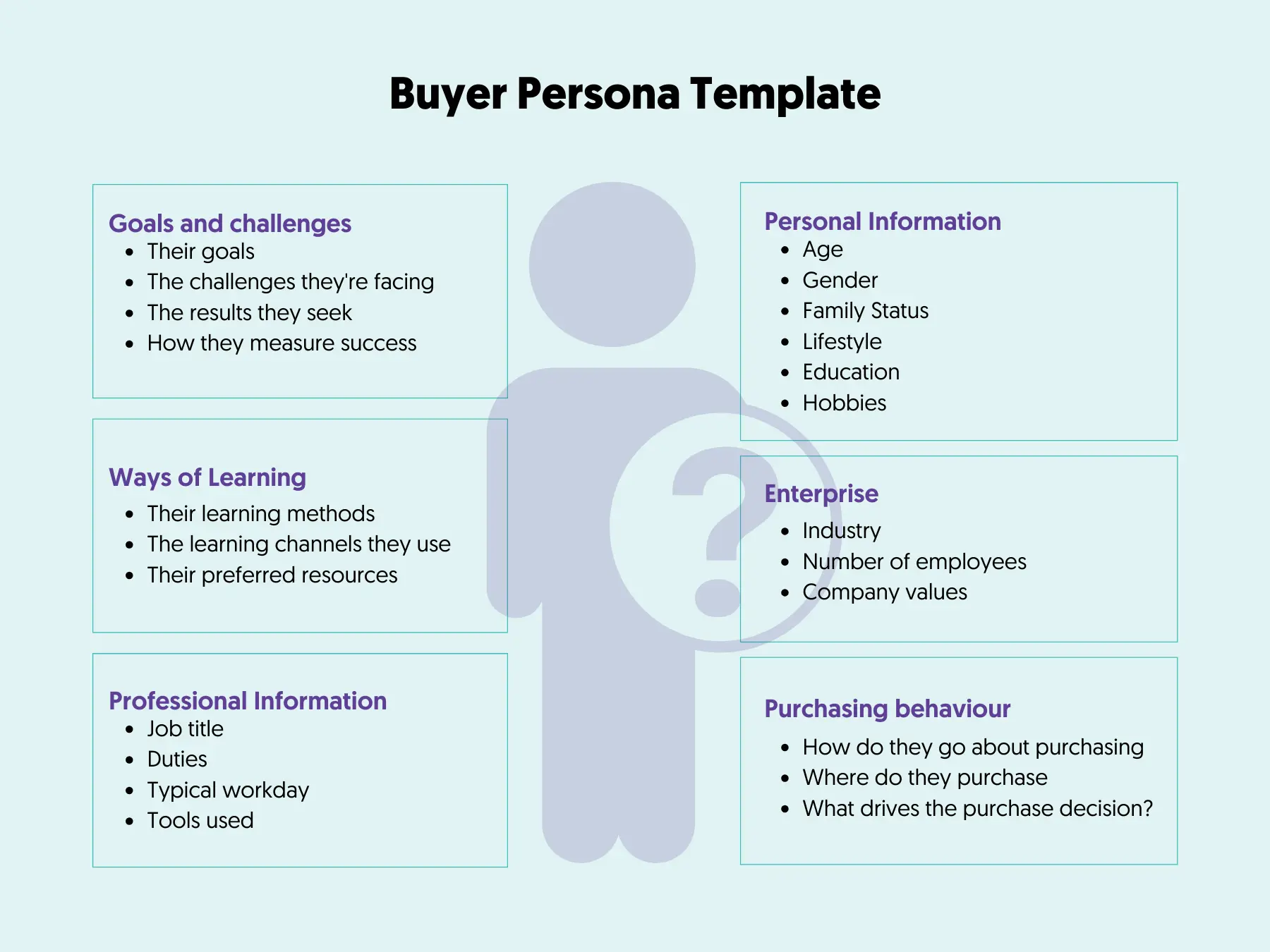
The information gathered in this step can help you tailor your SEO strategy and will also help with your social and PPC campaigns. Knowing your target audience's demographics, habits, and behaviors is essential for reaching the right people with ads.
2. Conduct B2B Keyword Research
The next step is to take what you've learned about your customers and perform keyword research. Your goal is to find the keywords, search phrases, and questions people use in search engines to express interest in products or services related to your offerings.
For this step, you must use a keyword research tool like Semrush or Aherfs and Google Search.
Here is an example to help you understand how to carry out this process successfully. Imagine you are doing SEO for a SaaS invoicing platform. Based on your buyer persona research, you've identified that your potential customers are small business owners looking for a solution for their invoicing needs. They want a product that is easy to use, not expensive, and secure.
When searching on Google, they use phrases like "invoicing software for small businesses" and "invoice software". So far, there are no surprises; these are obvious phrases you already know, and your competitors are already targeting.
As in every niche, these highly-targeted queries are also very competitive. You want to find other less competitive keywords to increase your chances of achieving a high Google ranking and getting targeted traffic.
When you analyze the primary keyword "invoice software" in the Semrush Keyword Magic tool and sort the results by keyword difficulty, you'll notice that phrases like "invoicing software for construction" and "invoicing software for freelancers" (and many other niche-specific terms) have a decent number of monthly searches and less competition than the obvious keywords that everybody else in your industry is targeting.
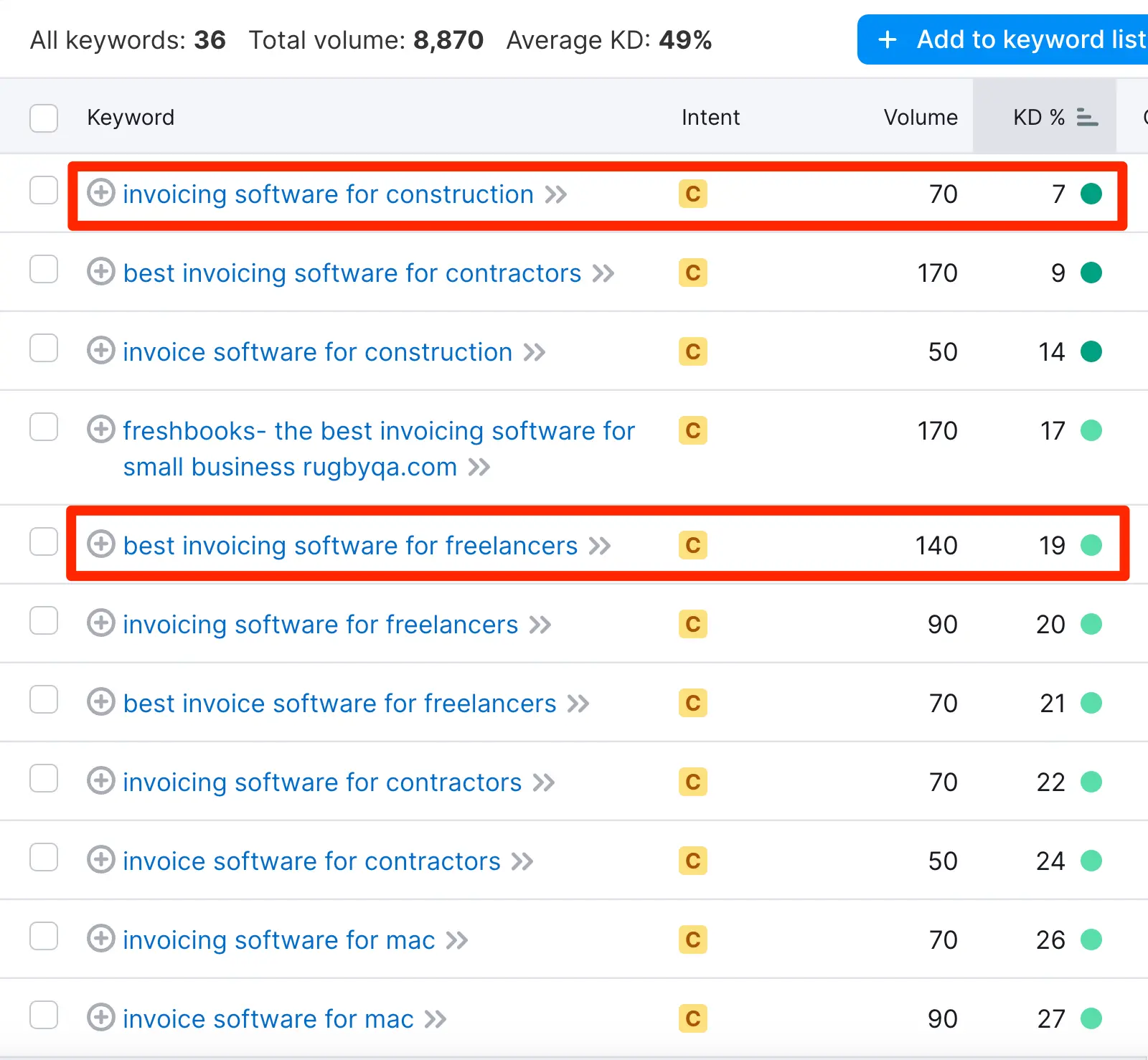
These are great keyword candidates for blog posts and landing pages.
Repeat the same research on Google using the autocomplete feature (type in your target keyword followed by letters of the alphabet to get suggestions), and you'll discover many more keyword opportunities.
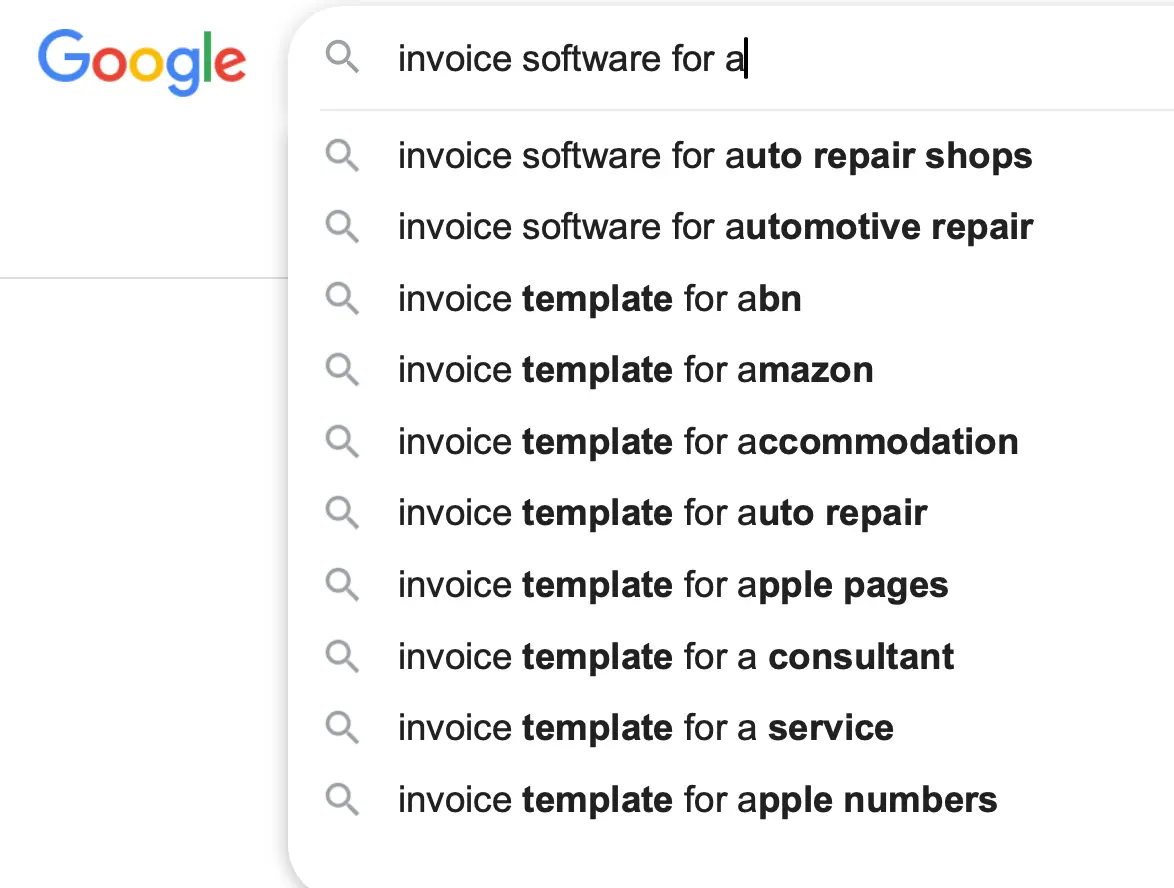
While in Googe, scroll down to the 'People Also Ask' section and "Related Searches". These questions are gold mines for your SEO strategy because they represent your target audience's exact concerns and interests.
By the end of this step, you should have a big list of keywords that will include different kinds of keywords like:
- Informational: "Do I have to use invoicing software for my small business?".
- Transactional: "Best invoicing for garage".
- Commercial: "Free invoice software for small businesses"
3. Map Keywords to The Sales Funnel
The next step is to organize your keywords based on the user's search intent. The easiest way is to think about your sales channel and map keywords for each stage.
A typical sales channel for a B2B business has three stages:
- Awareness: The customer is looking for general solutions to their problems, i.e., do I need invoicing software?
- Consideration: The customer is looking for options, i.e., What is the best invoicing software for freelancers?
- Conversion: The customer is looking for a specific product or service, i.e., FreshBooks vs QuickBooks.
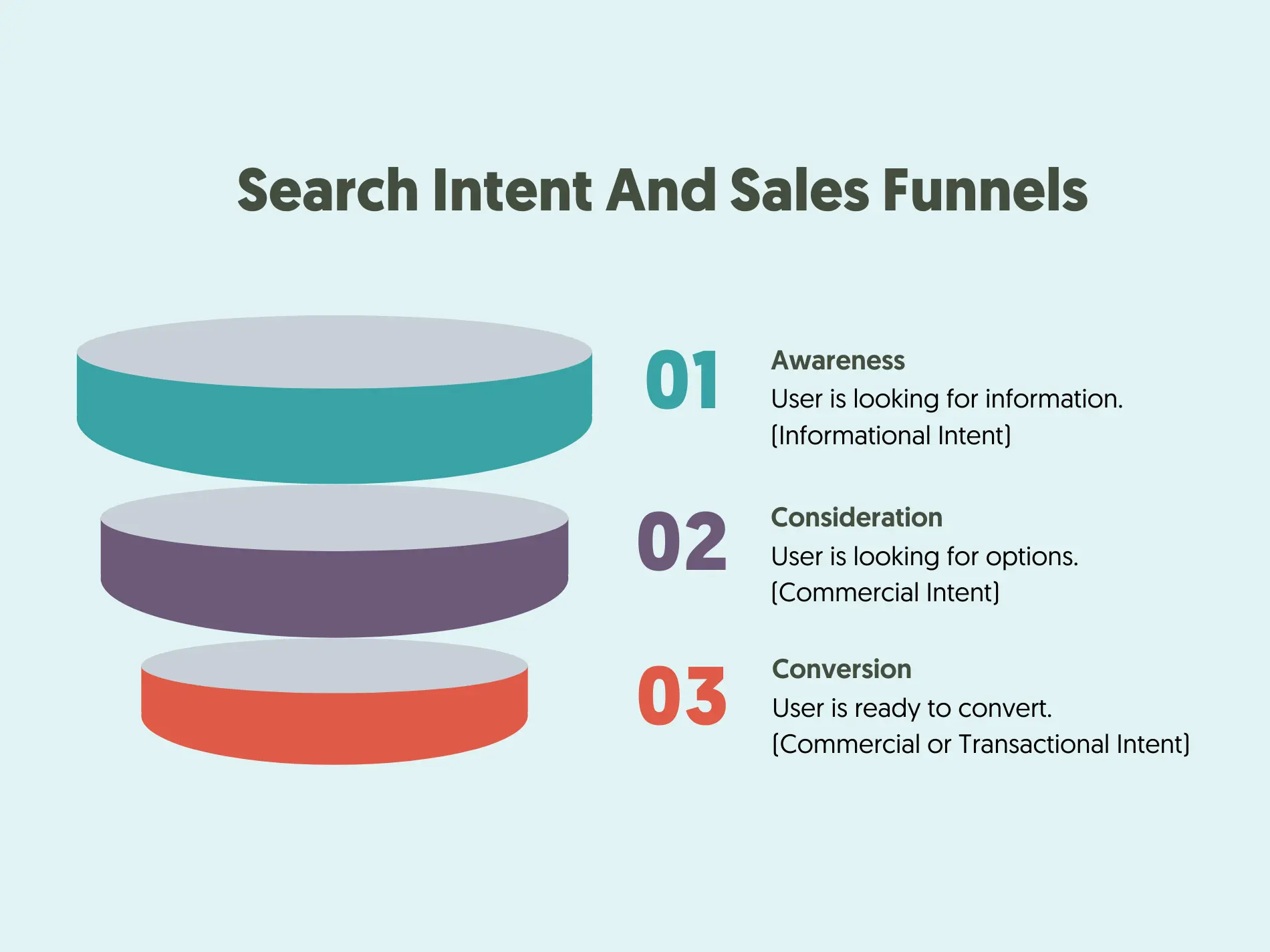
This may sound not easy, but it doesn't have to be. It's just a way to organize your keywords into topics so you can more easily target them with content (as we'll see in step 5 below).
For now, try to figure out what keywords, questions, and concerns potential customers may have while in the different sales funnel stages.
4. Develop a B2B Content Strategy
The next step is developing a content strategy, the most important part of B2B SEO marketing. A content strategy has many steps, but you should focus on these three elements:
1. Create a content marketing plan
Based on the results of your keyword research, create a plan to document when each piece of content will be published. You'll probably have a long list, so prioritize topics more likely to generate sales or leads.
But don't overdo it. A well-designed content strategy is balanced and not too promotional. In SEO, publishing too many pages with a commercial or transactional intent can damage your Google rankings.
Instead, you should publish different types of content, including informational and educational, to create a hub of useful information for your readers and not search engines.
When creating your plan, try to involve everybody in your company, regardless of their role. For example, managers can write content in a language other managers can relate to, or your developers can explain why your software or product is secure.
This approach will help you demonstrate thought leadership, and it will have a positive effect on your brand reputation and rankings.
2. A procedure for consistently crafting high-quality content
The truth is, to succeed with B2B SEO, you'll need a lot of content, especially if you have a lot of competitors. Thus, It is important to have a scalable system that will allow you to produce high-quality content consistently.
At the bare minimum, you need a content strategist who will decide what each piece of content will cover, experts who will write the content, and editors to ensure that the final outcome meets your content quality guidelines.
Don't follow the easy path of hiring general writers to produce the same content that is already online. It's a waste of time, money, and resources. Instead, treat each piece of content as a marketing asset that presents your brand and products in the best possible way.
3. Publishing different types of content for all stages of the sales funnel
Utilize your keyword list and topic buckets from your keyword research to guide content creation for each sales funnel stage.
This involves crafting a mix of informational blog posts, in-depth guides, case studies, and product demonstrations.
For example, you can create blog posts for the awareness stage to answer common questions.
For the consideration stage, you can create videos and how-to guides demonstrating how your products or services solve specific problems.
For the decision stage, you can create content to help prospects make purchasing decisions, such as listicles, comparison sheets, or detailed case studies showcasing your solutions' success.
5. Optimize Landing Pages For B2B Customers
Creating dedicated landing pages for your transactional keywords is one of the best ways to increase conversions for your B2B business.
For example, you could create a page on "Invoicing software for electricians" to explain how your software can specifically help electricians with their invoicing needs.
In your page, besides using landing page best practices, you should include the following:
- Headings and subheadings outlining the benefits of your solution, specific to B2B audiences (in this case, electricians).
- A detailed explanation of all product features emphasizing how each feature addresses common challenges your audience faces in managing invoices. Make sure to highlight unique selling points (USPs) that differentiate you from competitors.
- Include real case studies and testimonials from businesses similar to your target customers.
- Encourage visitors to try your product by offering a free demo or trial. Make the sign-up process straightforward, requiring minimal information.
- In an FAQ section, address common questions and concerns B2B customers might have regarding your product.
- Make it easy for potential customers to reach out with questions. Include a phone number, email, and a contact form directly on the landing page.
6. Promote Your Content To Get Mentions and Backlinks
One of the biggest mistakes B2B marketers make is doing everything correctly regarding keyword research and content creation but forgetting one critical step: content promotion.
To appear in the top positions of Google for B2B keywords, you need to convince the Google algorithm that your content is better than competitors. The best way to do this is through brand mentions and backlinks.
Here are some actionable ideas that work for B2B companies:
- Create a Google Business Profile, a Facebook Business Page, and register your business with any other credible institution (such as Better Business Bureau).
- Reach out to partners (or manufacturers) and existing customers and ask them to be included in their resources or partner lists.
- Create free tools related to your industry. People love them because they get free service and are more likely to attract natural links and mentions from other websites and even the press. For example, if you sell freight services, you can create a shipping cost estimator.
- Create case studies with a social nature and pitch them to journalists via paid ads. For example, you can create a study on how much shipping costs have increased over the last five years and their effect on consumer goods prices. With the right promotion strategy, this can get the attention of the press, and generate numerous benefits for your brand's reputation.
Read our link-building SEO guide for more tips.
7. Review Technical SEO And Fix Any Issues
Last but certainly not least, remember your technical SEO. Things like page speed, your website's appearance on mobile, website security (HTTPS), and the use of relevant schema markup play a role in rankings.
Before launching your SEO campaign, perform a complete SEO audit of your site to ensure that it is free of technical errors and that search engines can access the important pages of your website without any issues.



